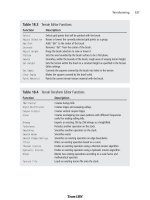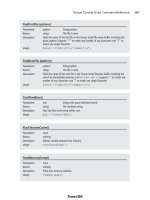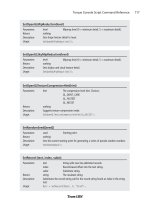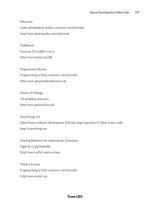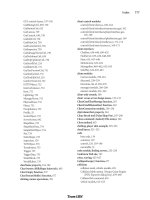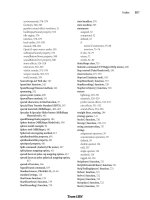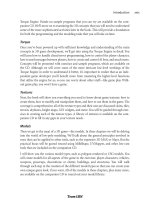Game Programming All in One 2 nd Edition phần 6 docx
Bạn đang xem bản rút gọn của tài liệu. Xem và tải ngay bản đầy đủ của tài liệu tại đây (1.05 MB, 74 trang )
scroll window. It is common to use the entire screen in scrolling-shooter games, but role-
playing games often use a smaller window on the screen for scrolling, using the rest of the
screen for gameplay (combat, inventory, and so on) and player/party information (see
Figure 10.2).
You could display one huge bitmap image in the virtual game world representing the cur-
rent level of the game, and then copy (blit) a portion of that virtual world onto the screen.
This is the simplest form of scrolling. Another method uses tiles to create the game world,
which I’ll cover shortly. First, you’ll write a short program to demonstrate how to use
bitmap scrolling.
A Limited View of the World
I have written a program called ScrollScreen that I will show you. The \chapter10\ScrollScreen
folder on the CD-ROM contains the bigbg.bmp file used in this program. Although I
encourage you to write the program yourself, feel free to load the project in either
KDevelop, Dev-C++, or Visual C++. Figure 10.3 shows the bigbg.bmp file.
When you run the program, the program will load the bigbg.bmp image into the virtual
buffer and display the upper-left corner in the 640×480 screen. (You can change the reso-
lution if you want, and I also encourage you to try running the program in full-screen
mode using
GFX_AUTODETECT_FULLSCREEN
for the best effect.) The program detects when the
A Limited View of the World 341
Figure 10.2 Some games use a smaller scroll window on the game screen.
arrow keys have been pressed and adjusts the
x
and
y
variables accordingly. Displaying the
correct view is then a simple matter of blitting with the
x
and
y
variables (see Figure 10.4).
Chapter 10
■
Programming Tile-Based Backgrounds with Scrolling342
Figure 10.3 The bigbg.bmp file is loaded into the virtual memory buffer
for scrolling.
Figure 10.4 The
ScrollScreen
program
demonstrates how to
perform virtual buffer
scrolling.
note
You could just as easily create a large virtual memory bitmap at run time and draw on that
bitmap using the Allegro drawing functions you have learned thus far. I have chosen to create
the bitmap image beforehand and load it into the program to keep the code listing shorter. Either
method works the same way.
#include <conio.h>
#include <stdlib.h>
#include “allegro.h”
//define some convenient constants
#define MODE GFX_AUTODETECT_FULLSCREEN
#define WIDTH 640
#define HEIGHT 480
#define STEP 8
//virtual buffer variable
BITMAP *scroll;
//position variables
int x=0, y=0;
//main function
void main(void)
{
//initialize allegro
allegro_init();
install_keyboard();
install_timer();
set_color_depth(16);
if (set_gfx_mode(MODE, WIDTH, HEIGHT, 0, 0) != 0)
{
set_gfx_mode(GFX_TEXT, 0, 0, 0, 0);
allegro_message(allegro_error);
return;
}
//load the large bitmap image from disk
scroll = load_bitmap(“bigbg.bmp”, NULL);
if (scroll == NULL)
{
set_gfx_mode(GFX_TEXT, 0, 0, 0, 0);
A Limited View of the World 343
allegro_message(“Error loading bigbg.bmp file”);
return;
}
//main loop
while (!key[KEY_ESC])
{
//check right arrow
if (key[KEY_RIGHT])
{
x += STEP;
if (x > scroll->w - WIDTH)
x = scroll->w - WIDTH;
}
//check left arrow
if (key[KEY_LEFT])
{
x -= STEP;
if (x < 0)
x = 0;
}
//check down arrow
if (key[KEY_DOWN])
{
y += STEP;
if (y > scroll->h - HEIGHT)
y = scroll->h - HEIGHT;
}
//check up arrow
if (key[KEY_UP])
{
y -= STEP;
if (y < 0)
y = 0;
}
//draw the scroll window portion of the virtual buffer
blit(scroll, screen, x, y, 0, 0, WIDTH-1, HEIGHT-1);
Chapter 10
■
Programming Tile-Based Backgrounds with Scrolling344
Introduction to Tile-Based Backgrounds 345
//slow it down
rest(20);
}
destroy_bitmap(scroll);
return;
}
END_OF_MAIN();
The first thing I would do to enhance this program is create two variables,
lastx
and
lasty
,
and set them to equal
x
and
y
, respectively, at the end of the main loop. Then, before blit-
ting the window, check to see whether
x
or
y
has changed since the last frame and skip the
blit
function. There is no need to keep blitting the same portion of the virtual back-
ground if it hasn’t moved.
Introduction to Tile-Based Backgrounds
You have seen what a simple scroller looks like, even though it relied on keyboard input
to scroll. A high-speed scrolling arcade game would automatically scroll horizontally or
vertically, displaying a ground-, air-, or space-based terrain below the player (usually rep-
resented by an airplane or a spaceship). The point of these games is to keep the action
moving so fast that the player doesn’t have a chance to rest from one wave of enemies to
the next. Two upcoming chapters have been dedicated to these very subjects! For the time
being, I want to keep things simple to cover the basics of scrolling before you delve into
these advanced chapters.
If you have gotten the
ScrollScreen
program to work, then you have taken the first step to
creating a scrolling arcade-style game (or one of the hundred-thousand or so games released
in the past 20 years). In the old days, getting the scroller working was usually the first step to
creating a sports game. In fact, that was my first assignment at Semi-Logic Entertainments back
in 1994, during the prototype phase of
Wayne Gretzky and the NHLPA All-Stars
—to get a
hockey rink to scroll as fast as possible.
Back then, I was using Borland C++ 4.5, and it just wasn’t fast enough. First of all, this was a 16-bit
compiler, while the 80×86- and Pentium-class PCs of the day were capable of 32-bit memory copies
(
mov
instruction) that could effectively draw four pixels at a time in 8-bit color mode or two pixels at
a time in 16-bit mode. Fortunately,Allegro already uses high-speed assembly instructions for blitting,
as the low-level functions are optimized for each operating system using assembly language.
tip
For an in-depth look at vertical scrolling, see Chapter 13, “Vertical Scrolling Arcade Games.” If you
prefer to go horizontal, you can look forward to Chapter 14, “Horizontal Scrolling Platform Games.”
Backgrounds and Scenery
A background is comprised of imagery or terrain in one form or another, upon which the
sprites are drawn. The background might be nothing more than a pretty picture behind
the action in a game, or it might take an active part, as in a scroller. When you are talking
about scrollers, they need not be relegated only to the high-speed arcade games. Role-
playing games are usually scrollers too, as are most sports games.
You should design the background around the goals of your game, not the other way
around. You should not come up with some cool background and then try to build the
game around it. (However, I admit that this is often how games are started.) You never
want to rely on a single cool technology as the basis for an entire game, or the game will
be forever remembered as a trendy game that tried to cash in on the latest fad. Instead of
following and imitating, set your own precedents and make your own standards!
What am I talking about, you might ask? You might have the impression that anything and
everything that could possibly have been done with a scrolling game has already been
done ten times over. Not true. Not true! Remember when Doom first came out? Everyone
had been imitating Wolfenstein 3-D when Carmack and Romero bumped up the notch a
few hundred points and raised everyone’s expectations so high that shockwaves reverber-
ated throughout the entire game industry—console and PC alike.
Do you really think it has all been done before and there is no more room for innovation,
that the game industry is saturated and it’s impossible to make a successful “indie” game?
That didn’t stop Bungie from going for broke on their first game project. Halo has made
its mark in gaming history by upping everyone’s expectations for superior physics and
intelligent opponents. Now, a few years hence, what kinds of games are coming out? What
is the biggest industry buzzword? Physics. Design a game today without it, and suddenly
your game is so 1990s in the gaming press. It’s all about physics and AI now, and that started
with Halo. Rather, it was perfected with Halo—I can’t personally recall a game with that
level of interaction before Halo came along. There is absolutely no reason why you can’t
invent the next innovation or revolution in gaming, even in a 2D game.
tip
Eh…all this philosophizing is giving me a headache. Time for some Strong Bad. Check out
for one of my favorites. Okay, back to business.
Chapter 10
■
Programming Tile-Based Backgrounds with Scrolling346
Creating Backgrounds from Tiles
The real power of a scrolling background comes from a technique called tiling. Tiling is a
process in which there really is no background, just an array of tiles that make up the
background as it is displayed. In other words, it is a virtual virtual background and it takes
up very little memory compared to a full bitmapped background (such as the one in
ScrollScreen). Take a look at Figure 10.5 for an example.
Can you count the number of tiles used to construct the background in Figure 10.5?
Eighteen tiles make up this image, actually. Imagine that—an entire game screen built
using a handful of tiles, and the result is pretty good! Obviously a real game would have
more than just grass, roads, rivers, and bridges; a real game would have sprites moving on
top of the background. How about an example? I thought you’d like that idea.
Tile-Based Scrolling
The TileScroll program uses tiles to fill the large background bitmap when the program
starts. Other than that initial change, the program functions exactly like the ScrollScreen
program. Take a look at Figure 10.6.
You might wonder why the screen looks like such a mess. That was intentional, not a mistake.
The tiles are drawn to the background randomly, so they’re all jumbled incoherently—
which is, after all, the nature of randomness. After this, I’ll show you how to place the tiles
in an actual order that makes sense. Also, you can look forward to an entire chapter ded-
icated to this subject in Chapter 12, “Creating a Game World: Editing Tiles and Levels.”
Introduction to Tile-Based Backgrounds 347
Figure 10.5 A bitmap image constructed of tiles
Why an entire chapter just
for this subject? Because it’s
huge! You’re just getting
into the basics here, but
Chapter 12 will explore
map editors, creating game
worlds, and other higher-
level concepts. The actual
bitmap containing the tiles
is shown in Figure 10.7.
Here’s the source code for the TileScroll program:
#include <conio.h>
#include <stdlib.h>
#include “allegro.h”
//define some convenient constants
#define MODE GFX_AUTODETECT_FULLSCREEN
#define WIDTH 640
#define HEIGHT 480
#define STEP 8
#define TILEW 32
#define TILEH 32
#define TILES 39
#define COLS 10
//temp bitmap
BITMAP *tiles;
//virtual background buffer
BITMAP *scroll;
//position variables
int x=0, y=0, n;
Chapter 10
■
Programming Tile-Based Backgrounds with Scrolling348
Figure 10.6 The
TileScroll
program demonstrates how to
perform tile-based background scrolling.
Figure 10.7 The source file
containing the tiles used in the
TileScroll
program
int tilex, tiley;
//reuse our friendly tile grabber from chapter 9
BITMAP *grabframe(BITMAP *source,
int width, int height,
int startx, int starty,
int columns, int frame)
{
BITMAP *temp = create_bitmap(width,height);
int x = startx + (frame % columns) * width;
int y = starty + (frame / columns) * height;
blit(source,temp,x,y,0,0,width,height);
return temp;
}
//main function
void main(void)
{
//initialize allegro
allegro_init();
install_keyboard();
install_timer();
srand(time(NULL));
set_color_depth(16);
//set video mode
if (set_gfx_mode(MODE, WIDTH, HEIGHT, 0, 0) != 0)
{
set_gfx_mode(GFX_TEXT, 0, 0, 0, 0);
allegro_message(allegro_error);
return;
}
//create the virtual background
scroll = create_bitmap(1600, 1200);
if (scroll == NULL)
{
set_gfx_mode(GFX_TEXT, 0, 0, 0, 0);
allegro_message(“Error creating virtual background”);
return;
Introduction to Tile-Based Backgrounds 349
}
//load the tile bitmap
tiles = load_bitmap(“tiles.bmp”, NULL);
if (tiles == NULL)
{
set_gfx_mode(GFX_TEXT, 0, 0, 0, 0);
allegro_message(“Error loading tiles.bmp file”);
return;
}
//now draw tiles randomly on virtual background
for (tiley=0; tiley < scroll->h; tiley+=TILEH)
{
for (tilex=0; tilex < scroll->w; tilex+=TILEW)
{
//pick a random tile
n = rand() % TILES;
//use the result of grabframe directly in blitter
blit(grabframe(tiles, TILEW+1, TILEH+1, 0, 0, COLS, n),
scroll, 0, 0, tilex, tiley, TILEW, TILEH);
}
}
//main loop
while (!key[KEY_ESC])
{
//check right arrow
if (key[KEY_RIGHT])
{
x += STEP;
if (x > scroll->w - WIDTH)
x = scroll->w - WIDTH;
}
//check left arrow
if (key[KEY_LEFT])
{
x -= STEP;
if (x < 0)
x = 0;
}
Chapter 10
■
Programming Tile-Based Backgrounds with Scrolling350
//check down arrow
if (key[KEY_DOWN])
{
y += STEP;
if (y > scroll->h - HEIGHT)
y = scroll->h - HEIGHT;
}
//check up arrow
if (key[KEY_UP])
{
y -= STEP;
if (y < 0)
y = 0;
}
//draw the scroll window portion of the virtual buffer
blit(scroll, screen, x, y, 0, 0, WIDTH-1, HEIGHT-1);
//slow it down
rest(20);
}
destroy_bitmap(scroll);
destroy_bitmap(tiles);
return;
}
END_OF_MAIN();
Creating a Tile Map
Displaying random tiles just to make a proof-of-concept is one thing, but it is not very
useful. True, you have some code to create a virtual background, load tiles onto it, and
then scroll the game world. What you really need won’t be covered until Chapter 12, so as
a compromise, you can create game levels using an array to represent the game world. In
the past, I have generated a realistic-looking game map with source code, using an algo-
rithm that matched terrain curves and straights (such as the road, bridge, and river) so
that I created an awesome map from scratch, all by myself. The result, I’m sure you’ll
agree, is one of the best maps ever made. Some errors in the tile matching occurred,
though, and a random map doesn’t have much point in general. I mean, building a ran-
dom landscape is one thing, but constructing it at run time is not a great solution—even
if your map-generating routine is very good. For instance, many games, such as Warcraft III,
Introduction to Tile-Based Backgrounds 351
Chapter 10
■
Programming Tile-Based Backgrounds with Scrolling352
Age of Mythology, and Civilization III, can generate the game world on the fly. Obviously,
the programmers spent a lot of time perfecting the world-generating routines. If your
game would benefit by featuring a randomly generated game world, then your work is cut
out for you but the results will be worth it. This is simply one of those design considera-
tions that you must make, given that you have time to develop it.
Assuming you don’t have the means to generate a random map at this time, you can sim-
ply create one within an array. Then you can modify the TileScroll program so it uses the
array. Where do you start? First of all, you should realize that the tiles are numbered and
should be referenced this way in the map array.
Here is what the array looks like, as defined in the GameWorld program:
int map[MAPW*MAPH] = {
0,0,0,0,0,0,0,0,0,0,0,0,0,0,0,0,0,0,0,0,0,0,0,0,0,
0,2,2,2,2,2,2,2,2,2,2,2,2,2,2,2,2,2,2,2,2,2,2,2,0,
0,2,2,2,2,2,2,2,2,2,2,2,2,2,2,2,2,2,2,2,2,2,2,2,0,
0,2,2,2,2,2,2,2,2,2,2,2,2,2,2,2,2,2,2,2,2,2,2,2,0,
0,2,2,2,2,2,2,2,2,2,2,2,2,2,2,2,2,2,2,2,2,2,2,2,0,
0,2,2,2,2,2,2,2,2,2,2,2,2,2,2,2,2,2,2,2,2,2,2,2,0,
0,2,2,2,2,2,2,2,2,2,2,2,2,2,2,2,2,2,2,2,2,2,2,2,0,
0,2,2,2,2,2,2,2,2,2,2,2,2,2,2,2,2,2,2,2,2,2,2,2,0,
0,2,2,2,2,2,2,2,2,2,2,2,2,2,2,2,2,2,2,2,2,2,2,2,0,
0,2,2,2,2,2,2,2,2,2,2,2,2,2,2,2,2,2,2,2,2,2,2,2,0,
0,2,2,2,2,2,2,2,2,2,2,2,2,2,2,2,2,2,2,2,2,2,2,2,0,
0,2,2,2,2,2,2,2,2,2,2,2,2,2,2,2,2,2,2,2,2,2,2,2,0,
0,2,2,2,2,2,2,2,2,2,2,2,2,2,2,2,2,2,2,2,2,2,2,2,0,
0,2,2,2,2,2,2,2,2,2,2,2,2,2,2,2,2,2,2,2,2,2,2,2,0,
0,2,2,2,2,2,2,2,2,2,2,2,2,2,2,2,2,2,2,2,2,2,2,2,0,
0,2,2,2,2,2,2,2,2,2,2,2,2,2,2,2,2,2,2,2,2,2,2,2,0,
0,2,2,2,2,2,2,2,2,2,2,2,2,2,2,2,2,2,2,2,2,2,2,2,0,
0,2,2,2,2,2,2,2,2,2,2,2,2,2,2,2,2,2,2,2,2,2,2,2,0,
0,2,2,2,2,2,2,2,2,2,2,2,2,2,2,2,2,2,2,2,2,2,2,2,0,
0,2,2,2,2,2,2,2,2,2,2,2,2,2,2,2,2,2,2,2,2,2,2,2,0,
0,2,2,2,2,2,2,2,2,2,2,2,2,2,2,2,2,2,2,2,2,2,2,2,0,
0,2,2,2,2,2,2,2,2,2,2,2,2,2,2,2,2,2,2,2,2,2,2,2,0,
0,2,2,2,2,2,2,2,2,2,2,2,2,2,2,2,2,2,2,2,2,2,2,2,0,
0,2,2,2,2,2,2,2,2,2,2,2,2,2,2,2,2,2,2,2,2,2,2,2,0,
0,0,0,0,0,0,0,0,0,0,0,0,0,0,0,0,0,0,0,0,0,0,0,0,0,
};
It’s not complicated—simply a bunch of twos (grass) bordered by zeroes (stone). The
trick here is that this is really only a single-dimensional array, but the listing makes it obvi-
ous how the map will look because there are 25 numbers in each row—the same number
of tiles in each row. I did this intentionally so you can use this as a template for creating
your own maps. And you can create more than one map if you want. Simply change the
name of each map and reference the map you want in the
blit
function so that your new
map will show up. You are not limited in adding more tiles to each row. One interesting
thing you can try is making
map
a two-dimensional array containing many maps, and then
changing the map at run time! How about looking for the keys 1–9 (
KEY_1
,
KEY_2
,…
KEY_9
),
and then changing the map number to correspond to the key that was pressed? It would
be interesting to see the map change right before your eyes without re-running the program
(sort of like warping). Now are you starting to see the potential? You could use this simple
scrolling code as the basis for any of a hundred different games if you have the creative
gumption to do so.
I have prepared a legend of the tiles and the value for each in Figure 10.8. You can use the
legend while building your own maps.
note
All of the tiles used in this chapter were created by Ari
Feldman, and I also owe him a debt of gratitude for
creating most of the artwork used in this book. If you
would like to contact Ari to ask him about custom art-
work for your own game, you can reach him at
.
Call the new program GameWorld. This new
demo will be similar to TileScroll, but it will
use a map array instead of placing the tiles ran-
domly. This program will also use a smaller
virtual background to cut down on the size of
the map array. Why? Not to save memory, but
to make the program more manageable.
Because the virtual background was
1600×1200 in the previous program, it would require 50 columns of tiles across and 37
rows of tiles down to fill it! That is no problem at all for a map editor program, but it’s too
much data to type in manually. To make it more manageable, the new virtual background
will be 800 pixels across. I know, I know—that’s not much bigger than the 640×480 screen.
The point is to demonstrate how it will work, not to build a game engine, so don’t worry
about it. If you want to type in the values to create a bigger map, by all means, go for it!
That would be a great learning experience, as a matter of fact. For your purposes here (and
with my primary goal of being able to print an entire row of numbers in a single source
code line in the book), I’ll stick to 25 tiles across and 25 tiles down. You can work with a
map that is deeper than it is wide, which will allow you to test scrolling up and down fairly
well. Figure 10.9 shows the output from the GameWorld program.
Introduction to Tile-Based Backgrounds 353
Figure 10.8 A legend of the tiles and their
reference numbers used to create a map in
the
GameWorld
program
How about that source code? Let’s just add a few lines to the TileScroll program to come
up with this new version. I recommend creating a new project called GameWorld, setting
up the linker options for Allegro’s library file, and then pasting the source code from
TileScroll into the new main.c file in the GameWorld program. If you don’t feel like doing
all that, fine; go ahead and mess up the TileScroll program!
First, up near the top with the other defines, add these lines:
#define MAP_ACROSS 25
#define MAP_DOWN 25
#define MAPW MAP_ACROSS * TILEW
#define MAPH MAP_DOWN * TILEH
Then, of course, add the
map
array definition below the defines. (Refer back a few pages for
the listing.) Only one more change and you’re finished. You need to make a slight change
to the section of code that draws the tiles onto the virtual background bitmap. You can
remove the line that sets
n
to a random number; simply change the
blit
line, noting the
change in bold. Note the last parameter of
grabframe
, which was changed from
n
to
map[n++]
. That’s the only change you need to make. Now go ahead and build this puppy,
and take it for a spin.
//now draw tiles randomly on virtual background
for (tiley=0; tiley < scroll->h; tiley+=TILEH)
Chapter 10
■
Programming Tile-Based Backgrounds with Scrolling354
Figure 10.9 The
GameWorld
program scrolls a map that was defined in
the
map
array.
{
for (tilex=0; tilex < scroll->w; tilex+=TILEW)
{
//use the result of grabframe directly in blitter
blit(grabframe(tiles, TILEW+1, TILEH+1, 0, 0, COLS, map[n++]),
scroll, 0, 0, tilex, tiley, TILEW, TILEH);
}
}
It’s a lot more interesting with a real map to scroll instead of jumbled tiles randomly
thrown about. I encourage you to modify and experiment with the GameWorld program
to see what it can do. Before you start making a lot of modifications, you’ll likely need the
help of some status information printed on the screen. If you want, here is an addition
you can make to the main loop, just following the
blit
. Again, this is optional.
//display status info
text_mode(-1);
textprintf(screen,font,0,0,makecol(0,0,0),
“Position = (%d,%d)”, x, y);
Enlarge the map to see how big you can make it. Try having the program scroll the map
(with wrapping) without requiring user input. This is actually a fairly advanced topic that
will be covered in future chapters on scrolling. You should definitely play around with the
map array to come up with your own map, and you can even try a different set of tiles. If
you have found any free game tiles on the Web (or if you have hired an artist to draw some
custom tiles for your game), note the layout and size of each tile, and then you can mod-
ify the constants in the GameWorld program to accommodate the new tile set. See what
you can come up with; experimentation is what puts the “science” in computer science.
Enhancing Tank War
I have been looking forward to this edition of Tank War since the first chapter in which
the program was introduced (Chapter 4). If you thought the previous chapter introduced
many changes to Tank War, you will be pleasantly surprised by all that will be put into the
game in this chapter! The only drawback is that at least half of the game has been revised,
but the result is well worth the effort. The game now features two (that’s right, two!)
scrolling game windows on the screen—one for each player. Shall I count the improve-
ments? There’s a new bitmap to replace the border and title; the game now uses scrolling
backgrounds that you can edit to create your own custom battlefields (one for each player);
the game is now double-buffered; debug messages have been removed; and the interface
has been spruced up. Take a look at Figure 10.10 for a glimpse of the new game.
Terrific, isn’t it? This game could seriously use some new levels with more creativity.
Remember, this is a tech demo at best, something to be used as a learning experience, so
Enhancing Tank War 355
it has to be easy to understand, not necessarily as awesome as it could be. I leave that to
you! After I’ve done the hard work and walked you through each step of the game, it’s your
job to create awesome new levels for the game. Of course, the game would also greatly
benefit from some sound effects, but that will have to wait for Chapter 15, “Mastering the
Audible Realm: Allegro’s Sound Support.”
Exploring the All-New Tank War
Since you’ll be spending so much time playing this great game with your friends (unless
you suffer from multiple personality disorder and are able to control both tanks at the same
time), let me give you a quick tour of the game, and then we’ll get started on the source
code. Figure 10.11 shows what the game looks like when player 2 hits player 1. The explo-
sion should occur on both windows at the same time, but herein lies a problem: We haven’t
covered timers yet! Soon enough; the next chapter covers this very important (and sorely
needed) subject.
Figure 10.12 shows both tanks engulfed in explosions. D’oh! Talk about mutually assured
destruction. You might be wondering where these ultra-cool explosions came from. Again,
thanks to Ari Feldman’s wonderful talent, we have an explosion sprite that can be rotated,
tweaked, and blitted to make those gnarly boom-booms. Imagine what this game will be
like with sound effects. I’m tempted to jump to that chapter right now so I can find out!
Chapter 10
■
Programming Tile-Based Backgrounds with Scrolling356
Figure 10.10
Tank War
now features two scrolling windows, one for
each player.
The next two figures show a sequence that is sad but true: Someone is going to die. Figure
10.13 shows player 1 having fired a bullet.
Referring to Figure 10.14—ooooh, direct hit; he’s toast.
Enhancing Tank War 357
Figure 10.11 Both of the scrolling windows in
Tank War
display
the bullets and explosions.
Figure 10.12 Mutually assured destruction: It’s what total war is all about.
The last image shows something interesting that I want to bring to your attention when you
are designing levels. Take a look at Figure 10.15.
Chapter 10
■
Programming Tile-Based Backgrounds with Scrolling358
Figure 10.13 Player 1 has fired. Bullet trajectory looks good….
Figure 10.14 Player 1 would like to thank his parents, his commander, and
all his new fans.
See how the border of the game world is black? That’s not just empty space; it’s a blank
tile from the tiles.bmp image. It is necessary to insert blanks around the edges of the map
so the tanks will seem to actually move up to the edge of the map. If you omit a border
like this, the tanks will not be able to reach the true border of the map. Just a little trick
for you at no cost, although I’m fairly certain someone has written a book about this.
The New Tank War Source Code
It’s time to get down and dirty with the new source code for Tank War. Let me paint the
picture this way and explain things straight up. Almost everything about the source has
been changed. I’m afraid a line-by-line change list isn’t possible this time because more
than half the game has been modified. I mean, come on—it’s got dual scrolling. What do
you expect, a couple of line changes? Er, sorry about that—been watching too much
Strong Bad. Let’s get started.
The first significant change to the game is that it is now spread across several source code
files. I decided this was easier to maintain and would be easier for you to understand, so
you don’t have to wade through the 10-page source code listing in a single main.c file. I’ll
go over this with you, but you feel free to load the project from \chapter10\tankwar on the
CD-ROM if you are in a hurry. I heartily recommend you follow along because there’s a
lot of real-world experience to be gained by watching how this game is built. Don’t be
a copy-paster!
Enhancing Tank War 359
Figure 10.15 The border around the game world is filled with a blank tile.
Header Definitions
First up is the tankwar.h file containing all the definitions for the game.
/////////////////////////////////////////////////////////////////////////
// Game Programming All In One, Second Edition
// Source Code Copyright (C)2004 by Jonathan S. Harbour
// Tank War Enhancement 5 - tankwar.h
/////////////////////////////////////////////////////////////////////////
#ifndef _TANKWAR_H
#define _TANKWAR_H
#include <conio.h>
#include <stdlib.h>
#include “allegro.h”
//define some game constants
#define MODE GFX_AUTODETECT_WINDOWED
#define WIDTH 640
#define HEIGHT 480
#define MAXSPEED 4
#define BULLETSPEED 10
#define TILEW 32
#define TILEH 32
#define TILES 39
#define COLS 10
#define MAP_ACROSS 31
#define MAP_DOWN 33
#define MAPW MAP_ACROSS * TILEW
#define MAPH MAP_DOWN * TILEH
#define SCROLLW 310
#define SCROLLH 375
//define some colors
#define TAN makecol(255,242,169)
#define BURST makecol(255,189,73)
#define BLACK makecol(0,0,0)
#define WHITE makecol(255,255,255)
#define GRAY makecol(128,128,128)
#define GREEN makecol(0,255,0)
//define the sprite structure
typedef struct SPRITE
Chapter 10
■
Programming Tile-Based Backgrounds with Scrolling360
{
//new elements
int dir, alive;
int x,y;
int width,height;
int xspeed,yspeed;
int xdelay,ydelay;
int xcount,ycount;
int curframe,maxframe,animdir;
int framecount,framedelay;
}SPRITE;
SPRITE mytanks[2];
SPRITE *tanks[2];
SPRITE mybullets[2];
SPRITE *bullets[2];
//declare some variables
int gameover;
int scores[2];
int scrollx[2], scrolly[2];
int startx[2], starty[2];
int tilex, tiley, n;
int radarx, radary;
//sprite bitmaps
BITMAP *tank_bmp[2][8];
BITMAP *bullet_bmp;
BITMAP *explode_bmp;
//the game map
extern int map[];
//double buffer
BITMAP *buffer;
//bitmap containing source tiles
BITMAP *tiles;
//virtual background buffer
BITMAP *scroll;
Enhancing Tank War 361
//screen background
BITMAP *back;
//function prototypes
void drawtank(int num);
void erasetank(int num);
void movetank(int num);
void explode(int num, int x, int y);
void movebullet(int num);
void drawbullet(int num);
void fireweapon(int num);
void forward(int num);
void backward(int num);
void turnleft(int num);
void turnright(int num);
void getinput();
void setuptanks();
void setupscreen();
int inside(int,int,int,int,int,int);
BITMAP *grabframe(BITMAP *, int, int, int, int, int, int);
#endif
Bullet Functions
I have transplanted all of the routines related to handling bullets and firing the weapons
into a file called bullet.c. Isolating the bullet code in this file makes it easy to locate these
functions without wading through a huge single listing. If you haven’t already, add a new
file to your Tank War project named bullet.c and type the code into this new file.
/////////////////////////////////////////////////////////////////////////
// Game Programming All In One, Second Edition
// Source Code Copyright (C)2004 by Jonathan S. Harbour
// Tank War Enhancement 5 - bullet.c
/////////////////////////////////////////////////////////////////////////
#include “tankwar.h”
void explode(int num, int x, int y)
{
int n;
//load explode image
if (explode_bmp == NULL)
Chapter 10
■
Programming Tile-Based Backgrounds with Scrolling362
{
explode_bmp = load_bitmap(“explode.bmp”, NULL);
}
//draw the explosion bitmap several times
for (n = 0; n < 5; n++)
{
rotate_sprite(screen, explode_bmp,
x + rand()%10 - 20, y + rand()%10 - 20,
itofix(rand()%255));
rest(30);
}
}
void drawbullet(int num)
{
int n;
int x, y;
x = bullets[num]->x;
y = bullets[num]->y;
//is the bullet active?
if (!bullets[num]->alive) return;
//draw bullet sprite
for (n=0; n<2; n++)
{
if (inside(x, y, scrollx[n], scrolly[n],
scrollx[n] + SCROLLW - bullet_bmp->w,
scrolly[n] + SCROLLH - bullet_bmp->h))
//draw bullet, adjust for scroll
draw_sprite(buffer, bullet_bmp, startx[n] + x-scrollx[n],
starty[n] + y-scrolly[n]);
}
//draw bullet on radar
putpixel(buffer, radarx + x/10, radary + y/12, WHITE);
}
void movebullet(int num)
Enhancing Tank War 363
{
int x, y, tx, ty;
x = bullets[num]->x;
y = bullets[num]->y;
//is the bullet active?
if (!bullets[num]->alive) return;
//move bullet
bullets[num]->x += bullets[num]->xspeed;
bullets[num]->y += bullets[num]->yspeed;
x = bullets[num]->x;
y = bullets[num]->y;
//stay within the virtual screen
if (x < 0 || x > MAPW-6 || y < 0 || y > MAPH-6)
{
bullets[num]->alive = 0;
return;
}
//look for a direct hit using basic collision
tx = scrollx[!num] + SCROLLW/2;
ty = scrolly[!num] + SCROLLH/2;
if (inside(x,y,tx-15,ty-15,tx+15,ty+15))
{
//kill the bullet
bullets[num]->alive = 0;
//blow up the tank
x = scrollx[!num] + SCROLLW/2;
y = scrolly[!num] + SCROLLH/2;
if (inside(x, y,
scrollx[num], scrolly[num],
scrollx[num] + SCROLLW, scrolly[num] + SCROLLH))
{
//draw explosion in my window
explode(num, startx[num]+x-scrollx[num],
starty[num]+y-scrolly[num]);
}
Chapter 10
■
Programming Tile-Based Backgrounds with Scrolling364
//draw explosion in enemy window
explode(num, tanks[!num]->x, tanks[!num]->y);
scores[num]++;
}
}
void fireweapon(int num)
{
int x = scrollx[num] + SCROLLW/2;
int y = scrolly[num] + SCROLLH/2;
//ready to fire again?
if (!bullets[num]->alive)
{
bullets[num]->alive = 1;
//fire bullet in direction tank is facing
switch (tanks[num]->dir)
{
//north
case 0:
bullets[num]->x = x-2;
bullets[num]->y = y-22;
bullets[num]->xspeed = 0;
bullets[num]->yspeed = -BULLETSPEED;
break;
//NE
case 1:
bullets[num]->x = x+18;
bullets[num]->y = y-18;
bullets[num]->xspeed = BULLETSPEED;
bullets[num]->yspeed = -BULLETSPEED;
break;
//east
case 2:
bullets[num]->x = x+22;
bullets[num]->y = y-2;
bullets[num]->xspeed = BULLETSPEED;
bullets[num]->yspeed = 0;
break;
//SE
case 3:
bullets[num]->x = x+18;
Enhancing Tank War 365
